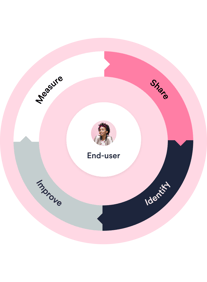There's an old tale about a donkey placed exactly halfway between two hay bales. Unable to decide how to get to the food, the fictional donkey starves. Sometimes, our work feels like this when we are trying to decide what to do first or what to do next. We see opportunities for improvement everywhere, and the priorities compete. As a result, we often—or at least sometimes—become paralyzed.
A company's management always has strategic goals. How well they communicate those goals varies widely from company to company, but employees and department heads doubtless have a list of things to accomplish to achieve them. Often, employee compensation, the likelihood of promotion, or even a future with the company depend on how well employees are pursuing those goals.
The Management-Employee Experience Rift
The company's management often thinks they are providing the proper tools and support for their employees. Research shows that isn't the case in many companies, however.
A study of 6,400 employees, HR professionals, and IT specialists by research firm Vanson Bourne, quoted by Scalable, found that:
- "95% of IT decision-makers thought that their IT functions provided employees with the digital tools they needed in order to be successful in their jobs, 42%—in other words, nearly half—of employees don't agree with this."
- "Nearly two-thirds of employees—64%—don't feel that they have a voice when it comes to which digital technologies they use at work. But 83% of IT decision-makers contested that employees did have a say in this."
Closing the Gap with ITXM
One way to ensure employees have a say is to commit to ITXM. The purpose of ITXM is to gather feedback (experiences) from employees who are the consumers of IT services, measure it, share it with others throughout the organization, and make improvements based on that feedback. A critical part of the framework is Identify where organizations decide how to make improvements and which to tackle first.

Part of the commitment to ITXM is recognizing that humans are the best sensors. If the people who do the work tell us that there is an issue causing lost time or difficulty, we should heed their feedback without being defensive or second-guessing them.
Improvements that have the most impact on the Happiness and Productivity of the employees are generally the ones that need to be addressed most swiftly. Sometimes, some of the improvements suggested by ITXM feedback align with the company's strategic goals. In those cases, the priorities are clear, and improvements almost suggest themselves.
If, on the other hand, a strategic goal is—for example—to get everyone in the enterprise to use a particular application, tool, or new and different hardware, and the change is causing a great deal of lost time and/or driving happiness downward, it is incumbent on the management to assess where and how changes need to be made. If they are genuinely committed to improving the employee experience, they must find a path forward that addresses both the experience and the desired outcome.
ITXM Is Not the Only Tool in the Shed
If the priority of the desired goal is high on the organization's list and ITXM feedback is negative, it's important to bring Organizational Change Management to bear. That OCM may include:
- Enhanced communication to help employees understand the need for the new application, tool, or hardware
- Incentives based on the adoption of a new way of working
- Training and other resources for employees to better understand the organizational goal and how the new application, tool, or hardware will help achieve it, as well as develop any needed skills
- A clear plan of action laying out what changes will be made and when
Of course, the instance of a conflict between management goals and ITXM feedback should not be the only case in which these OCM techniques are brought to bear, but when the larger organization—not only IT—understands the importance of the feedback, the path forward will be smoother.
Getting IT and Line of Business Management Working Together
One of the big lessons IT has learned over the past several years is that IT isn't separate from the rest of the organization but a real and vital part of it. A large portion of the work that takes place in any modern business is done using the tools and services IT provides and supports.
Understanding how the people who do the work are affected by those tools and services is the object of ITXM. Getting good data on how things are going and where the work happens is also useful for IT and other parts of the organization. Having ITXM data at the foundation of discussions between business and IT managers can defuse tensions—if they arise—and help guide the organization toward future improvements and budgeting decisions.
The Path Forward Has Already Been Blazed
The ITXM Framework exists to help organizations understand how their IT tools and technologies enable and assist employees in achieving the goals and objectives that organizational management has set. It is a clear and powerful way to view the employee experience with their technology—and the people who support it—from a fully human viewpoint using a proven method. The results can be seen in the continuing series of Global IT Experience Benchmark reports and the many Customer Cases available.
The first step in the ITXM journey is a commitment to the framework and—more importantly—honoring the experiences it represents.
One of management's most important jobs is to remove barriers that prevent people from reaching their goals. To discover exactly where those barriers exist, we must listen carefully to those who encounter them. When employees and management are aligned and respectful of each other, the road to improvement opens up, and an innovative future awaits. ITXM guides that alignment.





